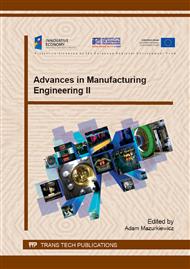[1]
Boroński D., Giesko T., Marciniak T., Lutowski Z., Bujnowski S.: The detection and measurement of fatigue cracklength with the use of the FatigueVIEW system, Przegląd Mechaniczny 4 (2014) 21-27.
DOI: 10.4028/www.scientific.net/kem.598.26
Google Scholar
[2]
Corpetti T., Memin E., Santa-Cruz A., Heitz D., Arroyo G.: Optical flow estimation in experimental fluid mechanics, IEEE 2003, pp.633-636.
DOI: 10.1109/isspa.2003.1224783
Google Scholar
[3]
Foucaut J. -M., Carlier J., Stanislas M.: PIV optimization for the study of turbulent flow using spectral analysis, 5th International Symposium on Particle Image Velocimetry 2003, pp.1-8.
Google Scholar
[4]
Lutowski Z., Marciniak T., Bujnowski S., Boroński D.: The optical system for elongation measurement of highly deformable materials, 2-2013 Problemy eksploatacji, Maintenance problems.
Google Scholar
[5]
Marciniak B., Marciniak T., Lutowski Z., Bujnowski S.: Usage of digital image correlation in analysis of cracking, Image Processing and Communications 2012, vol. 17, no. 3, pp.21-29.
DOI: 10.2478/v10248-012-0019-x
Google Scholar
[6]
Pul'nov Y., Preobrazhensky V., Pernod Ph., Smagin N.: Flow Velocity Measurements by Means of Nonlinear Interaction of Phase Conjugate Ultrasonic Waves, Ultrasonic Symposium 2005, pp.2100-2103.
DOI: 10.1109/ultsym.2005.1603295
Google Scholar
[7]
Shandas R., Kim H. -U., Hertzberg J.R., Mudadi O.: An ultrasound based method for measuring multiple velocity components in opaque macro and micro flows, 12th International Conference on Solid State Sensors, Actuators and Microsystems 2003, pp.919-922.
DOI: 10.1109/sensor.2003.1215625
Google Scholar
[8]
Umetsu K., Wajima K., Sawada K., Fujisaki K., Nishi S., Ueyama T.: Present Status of Electromagnetic Field Analysis and Its Application to Flow Control in Continous Caster Molds, Nippon Steel Technical Report, no. 67, pp.13-19.
Google Scholar


